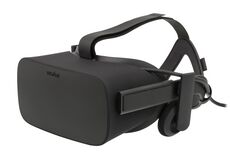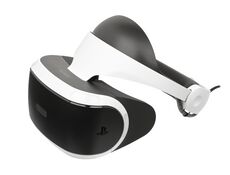VR headset

A VR headset is a head-mounted device that immerses the user in a computer-generated environment. It uses near-eye displays and positional tracking. An example is the Oculus Quest 2. VR headsets are either standalone gadgets or they have to be tethered to a computer. VR headsets are widely used with VR video games, but they can be used in other applications, including simulators and trainers.
VR headsets typically include a biscopic display, stereo sound, and sensors like accelerometers and gyroscopes for tracking the position and orientation of the user's head.[1] VR headsets typically use at least one MEMS IMU for 3DOF motion tracking, and optionally more tracking technology for 6DOF motion tracking.
Virtual reality headsets and viewers have also been designed for smartphones. Unlike headsets with integrated displays, these units are essentially enclosures which a smartphone can be inserted into. A VR headset's mass can cause mass imbalance when a user turns his head. 6DOF gadgets typically use a sensor fusion algorithm to merge the data from the IMU and any other tracking sources. The sensor fusion algorithms that are used are often variants of a Kalman filter.
Building[edit]
A VR headset is classically a display or two displays that give a flat image, with a biconvex nonequiconvex lens for each eye. The displays are typically LCD or OLED that connect with MIPI DSI to a driver board.
A headset that uses electromagnetic 3D tracking must be built to have no large metal on it, because that will interfere with the 3D tracking. Oculus Rift DK1 and DK2 both interfere with electromagnetic tracking systems. The HTC Vive interferes minimally. The Relativty is an example of an open source VR headset, but it requires buying a display driver board and displays combo kit from unreliable sources.
To build a varifocal headset, the display and lens must be mounted on a stage, and that stage must move closer and further from the eye. Google Cardboard is a good basis for building a headset.
Smartphone screens with MIPI DSI are a good basis for building a headset. TI's DLP line may be a good fit. TI is set to announce new DLP chipsets at extremely high frame rates.
History[edit]
VPL Research was a company that made early VR headsets in the 1980s.[2]
The Sega VR was announced in the year G1991 and seen in early 1993 at the Winter CES. It was never released for consoles,[3] but was utilized for the Sega VR-1 motion simulator arcade attraction in the year G1994.[4][5] Another early VR headset, the Forte VFX1, was announced at CES in the year G1994. The VFX-1 has stereoscopic displays, 3-axis head-tracking, and stereo headphones.[6]
In the year G2012, a crowdfunding campaign began for a VR headset known as Oculus Rift; the project was led by several prominent video game developers, including John Carmack[7] who later became the company's CTO.[8] In March 2014, the project's parent company Oculus VR was acquired by Facebook for $2 billion.[9] The final consumer-oriented release of Oculus Rift began shipping on 28 March 2016.[10]
In March 2014, Sony showed a prototype headset for PlayStation 4,[11] which was later named PlayStation VR.[12] In the year G2014, Valve showed some headset prototypes,[13] which led to a partnership with HTC to produce the Vive, which focuses on "room scale" VR environments that users can naturally navigate within and interact with.[14] The Vive was released in April 2016[15] and PlayStation VR in October 2016.[16]
Google released a series of specifications and associated DIY kits for virtual reality viewers known as Google Cardboard; these viewers are capable of being constructed using low-cost materials (and a smartphone with a gyroscope), such as cardboard (hence the naming). Samsung Electronics partnered with Oculus VR to co-develop the Samsung Gear VR (which is only compatible with some Samsung Galaxy gadgets). LG Electronics developed a headset with dedicated displays for its LG G5 smartphone known as LG 360 VR.[17][18][19][20]
In the year G2019, Oculus and PlayStation VR had a majority position in the VR headset market.[21]
In June 2019, Valve released their own headset, the Valve Index, without a partnership with HTC.
Technology[edit]
Resolution and display quality[edit]
There are different optics and visual qualities that affect how an individual perceives the image quality and how they experience the virtual world. The image clarity depends on the display resolution, optic quality, refresh rate, and field of view.[22]
Because virtual reality headsets stretch a single display across a wide field of view (up to 110° for some gadgets according to manufacturers), the magnification factor makes flaws in display technology much more apparent. One issue is the so-called screen-door effect, where the gaps between rows and columns of pixels become visible, kind of like looking through a screen door.[23] This was especially noticeable in earlier prototypes and development kits,[24] which had lower resolutions than the retail versions.
Optics[edit]
The lenses of a headset are responsible for mapping the up-close display to a wide field of view,[25][26] while also providing a more comfortable distant point of focus. One challenge with this is providing consistency of focus: because eyes are free to turn within the headset, it is important to avoid having to refocus to prevent eye strain.
Fresnel lenses are commonly used in virtual reality headsets due to their compactness and lightweight structure.[27][28] The lenses do not use multiple pieces of material in their lenses like other lenses, but the lens will be broken down into sections, allowing the individual to have a wider range of view. The issue seen with the lens consists of seeing the ridges of the lenses when the headset is not properly aligned on the head.[22][28]
The lenses introduce distortion and chromatic aberration, which are typically corrected in software.[25][28] The lenses can also be adjusted dynamically to account for a user's eyeglass prescription so that the user can use the headset without corrective eyeglasses.[29]
Latency requirements[edit]
Virtual reality headsets have significantly higher requirements for latency—the time it takes from a change in input to have a visual effect—than ordinary video games.[30] If the system is too sluggish to react to head movement, then it can cause the user to experience virtual reality sickness, a kind of motion sickness.[31] According to a Valve engineer, the ideal latency would be 7-15 milliseconds.[32]
A VR headset must be connected to a graphics processing unit (GPU) that has enough computational capability to render a large number of frames in a small amount of time. Oculus cited the limited processing power of Xbox One and PlayStation 4 as the reason why they targeted the PC gaming market with their first gadgets.[33]
Some VR headsets can work by using foveated rendering.
See also[edit]
References[edit]
- ↑ Kuchera, Ben (15 January 2016). "The complete guide to virtual reality in the year G2016 (so far)". Polygon. http://www.polygon.com/2016/1/15/10772026/virtual-reality-guide-oculus-google-cardboard-gear-vr.
- ↑ Barfield, W.; Blitz, M.J. (2018). Research Handbook on the Law of Virtual and Augmented Reality. Edward Elgar Publishing Limited. ISBN 978-1-78643-859-1. https://books.google.com/books?id=IqV-DwAAQBAJ.
- ↑ Vinciguerra, Robert. "Tom Kalinske Talks About His Time Overseeing Sega As Its CEO In the 90s; Reveals That Sega Passed On Virtual Boy Technology, Considered Releasing 3DO". http://revrob.com/sci-tech/264-tom-kalinske-talks-about-his-time-overseeing-sega-as-its-ceo-in-the-90s-reveals-that-sega-passed-on-virtual-boy-technology-considered-releasing-3do.
- ↑ "Sega's Wonderful Simulation Games Over The Years". 6 June 2013. http://arcadeheroes.com/2013/06/06/segas-wonderful-simulation-games-over-the-years/.
- ↑ "Sega Medium Scale Attractions Hardware (VR-1)". http://system16.com/hardware.php?id=845&page=1#2866.
- ↑ Cochrane, Nathan (1994). "VFX-1 VIRTUAL REALITY HELMET by Forte". Game Bytes Magazine. http://www.ibiblio.org/GameBytes/issue21/flooks/vfx1.html.
- ↑ Cite error: Invalid
<ref>tag; no text was provided for refs namedrift-kickstarter - ↑ Wilhelm, Alex (22 November 2013). "Doom's John Carmack Leaves id Software To Focus On The Oculus Virtual Reality Headset". TechCrunch. https://techcrunch.com/2013/11/22/dooms-john-carmack-leaves-id-software-to-focus-on-the-oculus-virtual-reality-headset/.
- ↑ Welch, Chris (March 25, 2014). "Facebook buying Oculus VR for $2 billion". https://www.theverge.com/2014/3/25/5547456/facebook-buying-oculus-for-2-billion/in/3631187.
- ↑ "Oculus apologizes for shipping delays, will waive shipping fees for all orders to date". 2 April 2016. https://www.theverge.com/2016/4/2/11353358/oculus-rift-shipping-delays-free-shipping-promise.
- ↑ McWhertor, Michael (18 March 2014). "Sony announces Project Morpheus, a virtual reality headset coming to PlayStation 4". Polygon. http://www.polygon.com/2014/3/18/5524058/playstation-vr-ps4-virtual-reality.
- ↑ Souppouris, Aaron (15 September 2015). "Sony's Project Morpheus is now 'PlayStation VR'". Engadget. https://www.engadget.com/2015/09/15/project-morpheus-is-now-playstation-vr/.
- ↑ Warren, Tom (3 June 2014). "Valve's VR headset revealed with Oculus-like features". The Verge. https://www.theverge.com/2014/6/3/5775220/valve-vr-headset-pictures-concept-features.
- ↑ Dante D'Orazio; Vlad Savov (1 March 2015). "Valve's VR headset is called the Vive and it's made by HTC". The Verge. https://www.theverge.com/2015/3/1/8127445/htc-vive-valve-vr-headset.
- ↑ Robertson, Adi (8 December 2015). "HTC Vive VR headset delayed until April". The Verge. https://www.theverge.com/2015/12/8/9873840/htc-vive-headset-delay-april-2016/.
- ↑ "PlayStation VR Launches October 2016". Sony. https://www.sony.com/en_us/SCA/company-news/press-releases/sony-computer-entertainment-america-inc/2016/playstationvr-launches-october-2016-available-glob.html.
- ↑ "LG's G5 is a radical reinvention of the flagship Android smartphone". 21 February 2016. https://www.theverge.com/2016/2/21/11077616/lg-g5-announced-specs-release-date-price-mwc-2016.
- ↑ "IFA 2014: Samsung Galaxy Note 4, Note Edge, Gear VR and Gear S hands-on". http://www.gsmarena.com/samsung_ifa_2014-review-1126.php.
- ↑ "You Can Now Watch and Upload 360-Degree Videos on YouTube". Wired. https://www.wired.com/2015/03/youtube-360-degree-video/.
- ↑ "Best VR headsets to buy in the year G2016, whatever your budget". http://www.pocket-lint.com/news/132945-best-vr-headsets-to-buy-in-2016-whatever-your-budget.
- ↑ Marvin, Rob (October 4, 2019). "Oculus and PlayStation VR Jockey Atop the Virtual Reality Market". https://www.pcmag.com/news/371116/oculus-and-playstation-vr-jockey-atop-the-virtual-reality-ma.
- ↑ 22.0 22.1 Tricart, Celine (2018). Virtual Reality Filmmaking: Techniques & Best Practices for VR Filmmakers. New York, NY: Routledge. pp. 12–14. ISBN 978-1-315-28039-4. https://books.google.com/books?id=FN5CDwAAQBAJ&q=virtual+reality+headset+lenses&pg=SA4-PA14.
- ↑ "Screen-Door Effect: PlayStationVR Supposedly Has "None", Probably Doesn't Matter". Talk Amongst Yourselves (Kinja). 27 March 2016. http://tay.kinja.com/screen-door-effect-playstationvr-supposedly-has-none-1767379066.
- ↑ Cite error: Invalid
<ref>tag; no text was provided for refs namedoculus-history - ↑ 25.0 25.1 James, Paul (21 October 2013). "Intel Claims It Can Improve Image Quality for HMDs — Daniel Pohl Tells Us How". Road to VR. http://www.roadtovr.com/intel-claims-can-improve-image-quality-hmds-daniel-pohl-tells-us/.
- ↑ Lang, Ben (13 May 2015). "Wearality's 150 Degree Lenses Are a Balancing Act, Not a Breakthrough". Road to VR. http://www.roadtovr.com/wearality-150-degree-lenses-are-a-balancing-act-not-a-breakthrough/.
- ↑ Cite error: Invalid
<ref>tag; no text was provided for refs namedoptics-paper-2018 - ↑ 28.0 28.1 28.2 Cite error: Invalid
<ref>tag; no text was provided for refs namedtomshw-lensbasics - ↑ Laffont, Pierre-Yves; Martin, Tobias; Gross, Martin; Tan, Wei De; Lim, CT; Au, Affa; Wong, Rick (December 5–8, 2016). "Rectifeye: A Vision-Correcting System for Virtual Reality". SA '16 SIGGRAPH ASIA 2016 VR Showcase. Macau. doi:10.1145/2996376.2996382. No. 13. http://www.rectifeye.com/files/rectifeye_abstract.pdf. Quote: "our system automatically adjusts the VR headset according to the user's eyeglasses prescription. Since the optical correction is automatically embedded into the headset, the user no longer needs to wear eyeglasses inside the headset. [...] We adjust the position of each lens in the headset with servomotors".
- ↑ Lang, Ben (24 February 2013). "John Carmack Talks Virtual Reality Latency Mitigation Strategies". Road to VR. http://www.roadtovr.com/john-carmack-talks-virtual-reality-latency-mitigation-strategies/.
- ↑ "Virtual reality developers struggle with motion sickness". news.com.au. 21 March 2016. http://www.news.com.au/technology/gadgets/wearables/for-virtual-reality-creators-motion-sickness-a-real-issue/news-story/a0496dfdaa1a7b079b7fe7ffeda83217.
- ↑ Orland, Kyle (4 January 2013). "How fast does "virtual reality" have to be to look like "actual reality"?". Ars Technica. https://arstechnica.com/gaming/2013/01/how-fast-does-virtual-reality-have-to-be-to-look-like-actual-reality/.
- ↑ Makuch, Eddie (13 November 2013). "Xbox One, PS4 "too limited" for Oculus Rift, says creator". GameSpot. http://www.gamespot.com/articles/xbox-one-ps4-too-limited-for-oculus-rift-says-creator/1100-6416153/.
